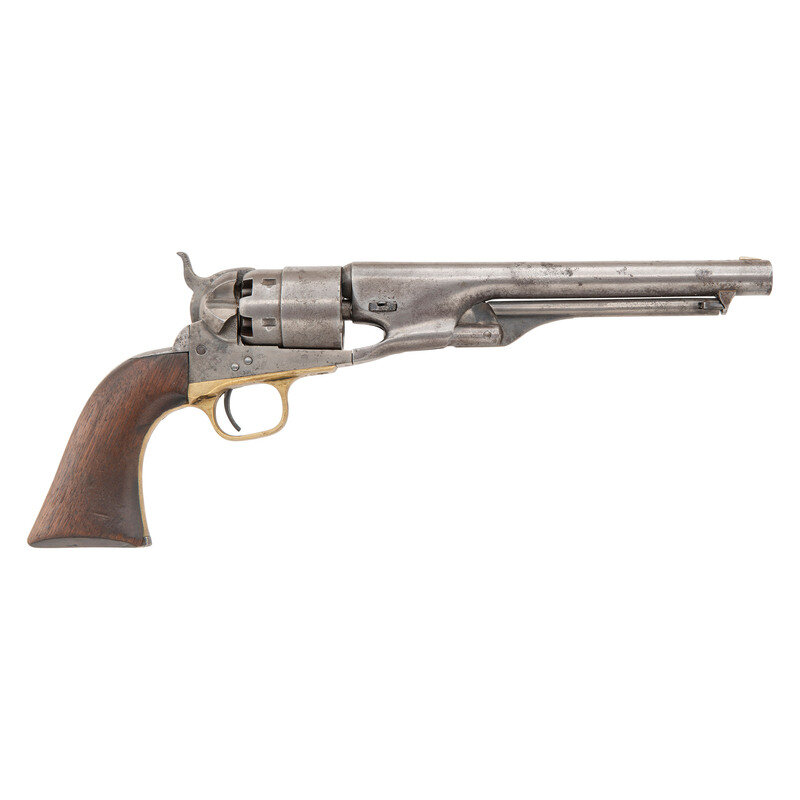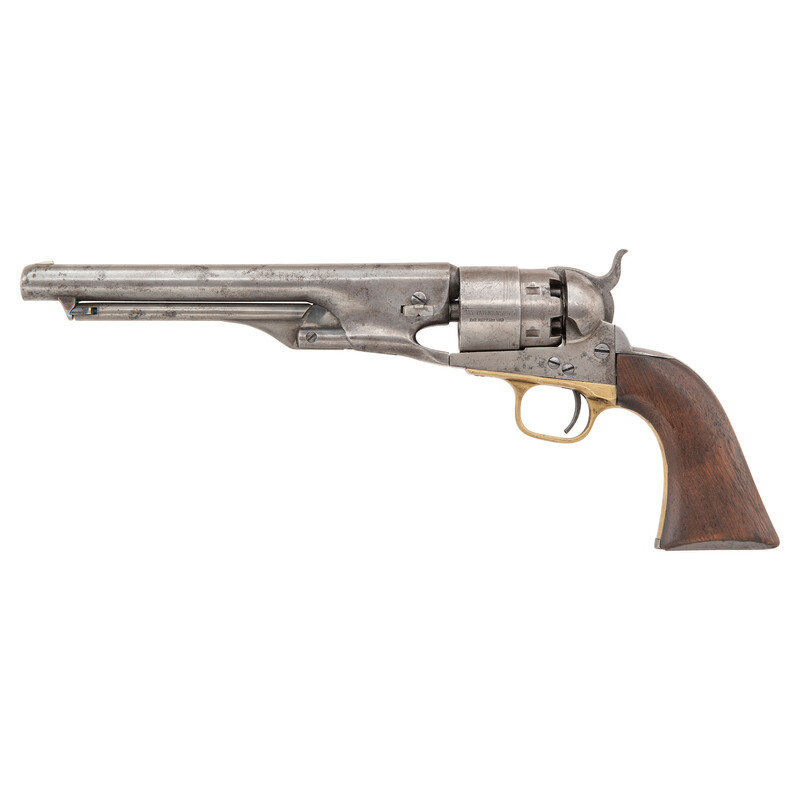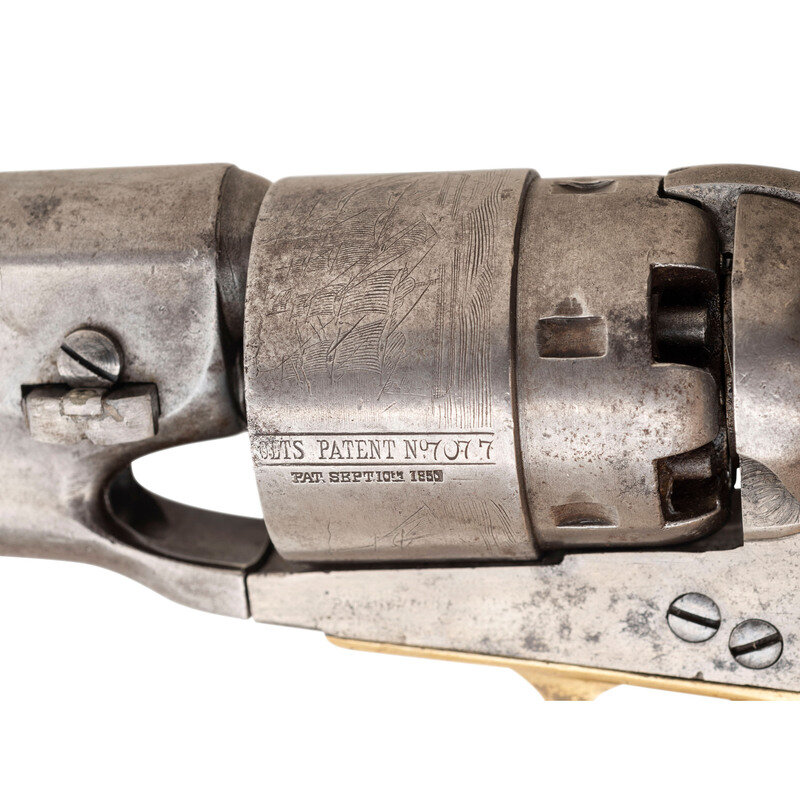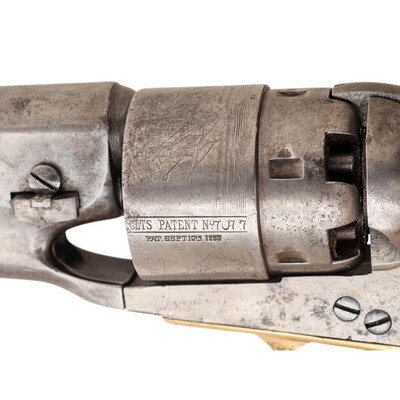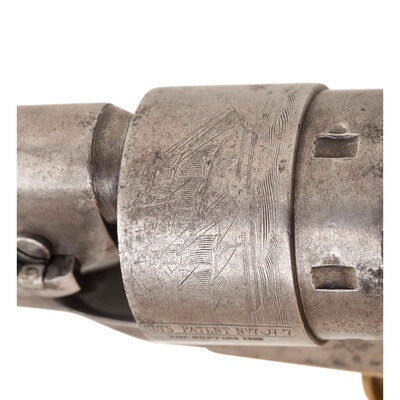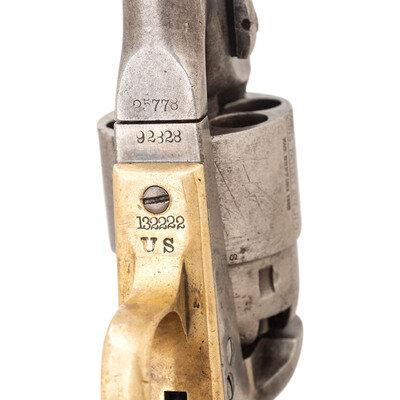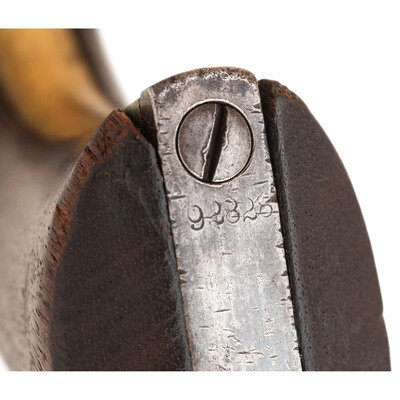"US" Marked Arsenal Rebuilt Colt 1860 Army Revolver - Likely Buffalo Soldier Issued
Sale 2030 - Arms, Armor and Militaria
Oct 23, 2024
10:00AM ET
Live / Cincinnati
Estimate
$2,000 -
3,000
Lot Description
"US" Marked Arsenal Rebuilt Colt 1860 Army Revolver - Likely Buffalo Soldier Issued
Indian Wars
.44 caliber. 7.875" barrel. SN: 92828 (mfg. ca. 1862). No finish remaining, brass triggerguard, one piece walnut grip. Single action percussion revolver with three-screw frame, six chambered cylinder, hammer nose notch rear sight and German silver blade front sight. Barrel with weak one-line New York address, frame with very weak patent markings, all from the arsenal refurbishment. Large US stamped on triggerguard plate, forward of the bow. Mixed numbers with the frame and butt numbered 92828, and arbor matching numbered 2828. Barrel numbered 25778, triggerguard 132222, cylinder 7077 and wedge 6917. The grip is unnumbered. From the Collection of Charles Worman, co-author of the two volume set Firearms of the American West.
According to research in The Colt Model 1860 Army Revolver by Charles W. Pate we know that by May of 1867, the Ordnance Department reported only 1,611 “serviceable” Colt Army revolvers available for issue, with an additional 5,454 in inventory that needed repairs. As the supply of available Colt Army revolvers in the various arsenals and depots was so severely depleted, a significant program of “cleaning and repairing” (C&R) was undertaken to place revolvers back into service. This was a multi-faceted approach that refurbished the guns to make them functional and often included refinishing as well. In many cases the arms were reassembled using salvaged parts from other guns, which resulted in mixed number revolvers. Within the group of refurbished, “cleaned & repaired” Colt Army revolvers is a smaller sub-set of revolvers that is estimated to include between 1,000 and 1,500 guns that were marked US on their triggerguard plates, forward of the triggerguard bow. This mark is in addition to the guns showing the usual indications of an arsenal rebuild. Mr. Pate has undertaken a major analysis of some 118 known, surviving examples of these special M1860 Army revolvers and has made some interesting discoveries and drawn some interesting conclusions about these guns. For years, collectors have referred to these guns as having been rebuilt at the Springfield Arsenal. However, his research in the arsenal records has determined this not to be the case. Rather, based upon his findings, the guns were rebuilt either at the St. Louis Arsenal or in Leavenworth, although St. Louis appears to be the most likely location. Mr. Pate believes that all of the “US” marked examples were rebuilt during the same period of a few months circa 1867-1869 at one of these facilities and has determined that a number of specific features are common to the guns. All bear the US mark on the triggerguard, without “periods” between the letters. The guns usually show at least one mismatched part, often several, but the theory that no regard to matching numbers during the reassembly of the guns is not completely true, as most show matching groups of parts. The guns typically show signs of having been refinished, with weak markings, polishing marks, particularly a line on the right side of the frame above the hammer screw, as well other indicators of being refinished, even though the guns usually show heavy wear and use after they were rebuilt and rarely retain any finish at all. The guns almost all have barrels that are slightly short of full-length, typically between .125” and .25” shorter than when new. Grips often fit poorly, no doubt due to being salvaged from other guns, thus not matching the grip frame contours of the gun they have been added to. Mr. Pate was able to verify the theory that many of these guns were subsequently issued to the 10th US Cavalry, the legendary “Buffalo Soldier” cavalry regiments. A rare and desirable revolver from the Indian Wars period.
According to research in The Colt Model 1860 Army Revolver by Charles W. Pate we know that by May of 1867, the Ordnance Department reported only 1,611 “serviceable” Colt Army revolvers available for issue, with an additional 5,454 in inventory that needed repairs. As the supply of available Colt Army revolvers in the various arsenals and depots was so severely depleted, a significant program of “cleaning and repairing” (C&R) was undertaken to place revolvers back into service. This was a multi-faceted approach that refurbished the guns to make them functional and often included refinishing as well. In many cases the arms were reassembled using salvaged parts from other guns, which resulted in mixed number revolvers. Within the group of refurbished, “cleaned & repaired” Colt Army revolvers is a smaller sub-set of revolvers that is estimated to include between 1,000 and 1,500 guns that were marked US on their triggerguard plates, forward of the triggerguard bow. This mark is in addition to the guns showing the usual indications of an arsenal rebuild. Mr. Pate has undertaken a major analysis of some 118 known, surviving examples of these special M1860 Army revolvers and has made some interesting discoveries and drawn some interesting conclusions about these guns. For years, collectors have referred to these guns as having been rebuilt at the Springfield Arsenal. However, his research in the arsenal records has determined this not to be the case. Rather, based upon his findings, the guns were rebuilt either at the St. Louis Arsenal or in Leavenworth, although St. Louis appears to be the most likely location. Mr. Pate believes that all of the “US” marked examples were rebuilt during the same period of a few months circa 1867-1869 at one of these facilities and has determined that a number of specific features are common to the guns. All bear the US mark on the triggerguard, without “periods” between the letters. The guns usually show at least one mismatched part, often several, but the theory that no regard to matching numbers during the reassembly of the guns is not completely true, as most show matching groups of parts. The guns typically show signs of having been refinished, with weak markings, polishing marks, particularly a line on the right side of the frame above the hammer screw, as well other indicators of being refinished, even though the guns usually show heavy wear and use after they were rebuilt and rarely retain any finish at all. The guns almost all have barrels that are slightly short of full-length, typically between .125” and .25” shorter than when new. Grips often fit poorly, no doubt due to being salvaged from other guns, thus not matching the grip frame contours of the gun they have been added to. Mr. Pate was able to verify the theory that many of these guns were subsequently issued to the 10th US Cavalry, the legendary “Buffalo Soldier” cavalry regiments. A rare and desirable revolver from the Indian Wars period.
This lot is located in Cincinnati.
From the Collection of Charles Worman
Condition Report
Auction Specialists
